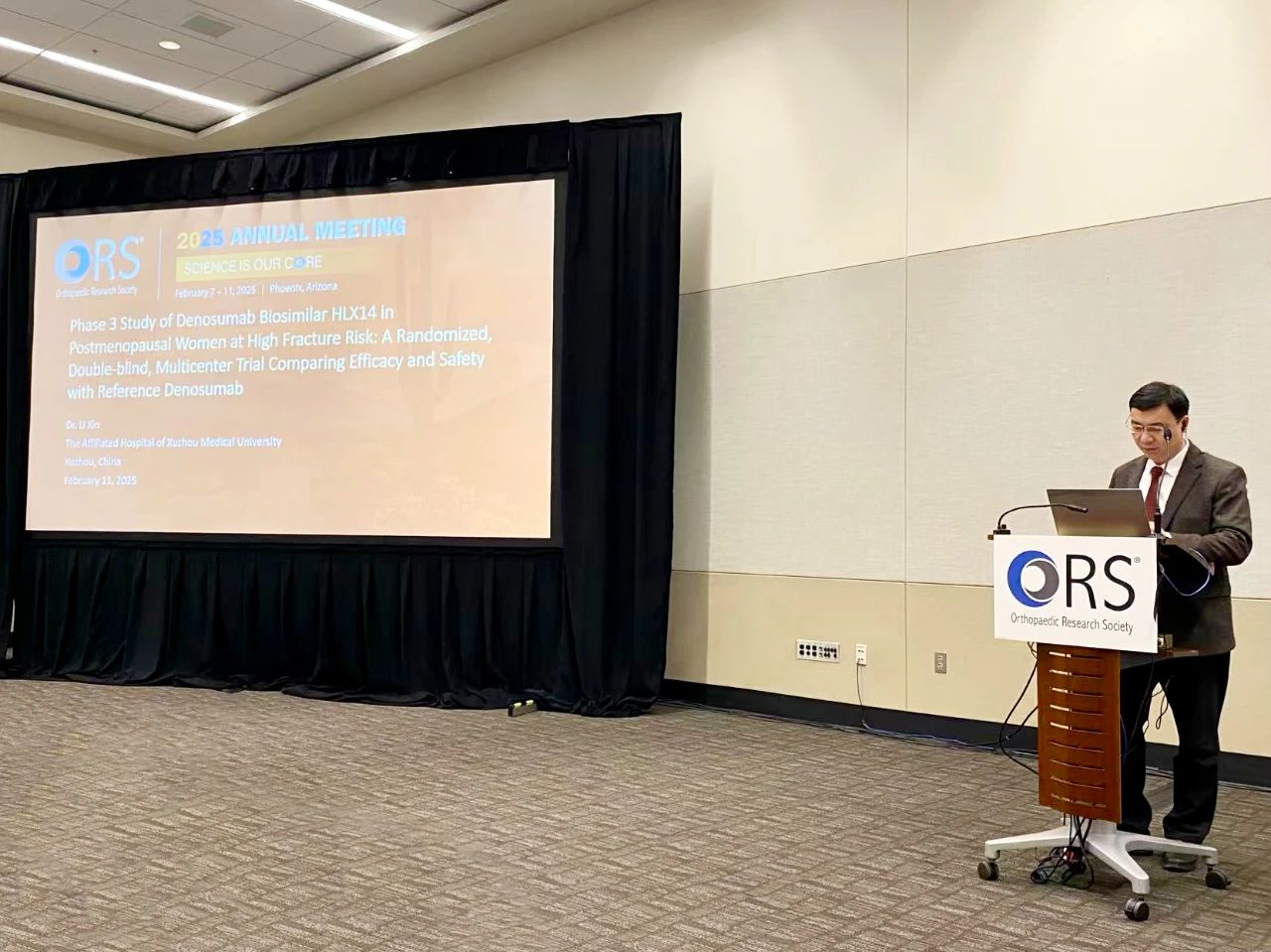On February 11, 2025, the results of the international multicenter phase 3 study (NCT05352516) of denosumab biosimilar candidate HLX14 were released at the 2025 Orthopaedic Research Society (ORS) Annual Meeting. The results were orally presented by Professor Li Xin from The Affiliated Hospital of Xuzhou Medical University, the leading principal investigator of NCT05352516.

Henlius independently developed denosumab biosimilar candidate HLX14 in accordance with the NMPA, EMA, FDA, and other international biosimilar guidelines. In 2022, Henlius entered into a license and supply agreement with Organon for the exclusive commercialization rights to two biosimilar candidates, including HLX14. The agreement covers markets such as the United States, the European Union, and Canada. An exception from the agreement is China. In April 2024, NCT05352516 met the primary endpoints. Based on a series of head-to-head comparison studies, the marketing applications of HLX14 have been accepted by the U.S. Food and Drug Administration (FDA), the European Medicines Agency (EMA), and Health Canada in 2024.
The detailed results of the study released at ORS 2025 Annual Meeting are as follows:
Study design
In this randomized, double-blind, international multicenter, parallel-controlled phase 3 study, female subjects aged 60 to 90 years with confirmed postmenopausal status and lumbar spine or total hip bone mineral density (BMD) T-score of −4.0 < T-score ≤ −2.5 as assessed by central dual-energy X-ray absorptiometry scans were initially randomized 1:1 to receive two doses of HLX14 or EU-denosumab. At Week 52, the subjects receiving EU-denosumab were re-randomized 1:1 to receive either a third dose of HLX14 or EU-denosumab, subjects receiving HLX14 will be continue with a third dose of HLX14. The co-primary endpoints were the percent change from baseline at lumbar spine BMD (LS-BMD) at week 52 as assessed by the central imaging, and the area under the effect-time curve for percent change of serum type I collagen C-telopeptide (s-CTX) from baseline to Week 26 (AUEC0-26W). Secondary endpoints included efficacy endpoints of the percent change from baseline in BMD at lumbar spine (assessed by the investigator), at femoral neck and total hip (as assessed by central imaging and investigator), fracture rate, relative percent change in s-CTX and serum procollagen type I N propeptide, safety, PK, and immunogenicity.
Results
Between 17 June, 2022 to 05 June, 2024, a total of 514 subjects were randomized to the HLX14 (n= 256) or EU-denosumab (n=258) group. At Week 52, 220 subjects from the EU-denosumab group were re-randomized to receive a final dose of HLX14 (EU-denosumab/HLX14 group, n=110) or EU-denosumab (EU-denosumab/EU-denosumab group, n=110); 220 subjects in the HLX14 group continued to receive the final dose of HLX14 (HLX14/HLX14 group).
From baseline to week 52, an increase in LS-BMD was evident in both the HLX14 and EU-denosumab groups; the mean (standard deviation) percent change from baseline to Week 52 as assessed by central imaging were 6.10% (3.95%), and 5.90% (3.83%) for the HLX14, and EU-denosumab group, respectively. The adjusted mean difference between the two groups was 0.23% (90% confidence interval [CI]: −0.36%, 0.83%; 95% CI: −0.48%, 0.95%). The 90% CI and 95% CI for the difference both fell within the pre-specified equivalence margins of −1.45% to 1.45%, demonstrating the efficacy equivalence between the two groups. As for the primary PD endpoint, the geomean (CVb%) of AUEC0‑26W for subjects in the HLX14, and EU-denosumab group were 14075.1253 (17.3%) day*%inhibition, and 13883.3613 (17.9%) day*%inhibition, respectively. The geometric mean ratio of AUEC0‑26W for the HLX14 and EU-denosumab groups was 1.01 (90% CI: 0.99, 1.04; 95% CI: 0.98, 1.05). The 90% CI and 95% CI for the geometric mean ratio of AUEC0‑26W both fell within the pre-specified equivalence margins of 0.8 to 1.25, demonstrating the PD equivalence between the two groups. Henceforth, the co-primary endpoints in this study were met. All sensitivity, supplementary and subgroup analysis were also consistent with the primary analysis. The results of all secondary endpoints support the efficacy equivalence between HLX14 and EU-denosumab.
The safety findings were comparable between the two groups from baseline to week 52; treatment-related adverse events (TRAEs) were reported in 69 (27.0%) subjects in the HLX14 group and 82 (31.8%) in the EU-denosumab group. Importantly, the safety profiles of the EU-denosumab/HLX14, EU-denosumab/EU-denosumab, and HLX14/HLX14 groups remained comparable from week 52 to week 78; TRAEs were observed in 14 (12.7%) in the EU-denosumab/HLX14 group, 15 (13.6%) in the EU-denosumab/EU-denosumab group, and 25 (11.4%) subjects in the HLX14/HLX14 group. Overall, the safety evaluation did not indicate notable differences between HLX14 and EU-denosumab, even after the single transition between the treatment drugs. Lastly, the incidence of anti-drug antibodies and neutralizing antibodies were also comparable between the groups prior to and after the single transition.
Conclusion
The efficacy equivalence of HLX14 and EU-denosumab was demonstrated along with comparable safety profiles for HLX14 and EU-denosumab. Taken together, the findings from this study add to the totality of evidence supporting HLX14 as a proposed biosimilar to reference denosumab that, if approved by regulatory agencies, may improve access to effective therapies for osteoporosis and bone loss in postmenopausal women at high risk of fracture.
